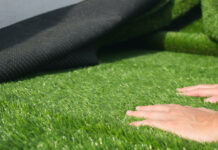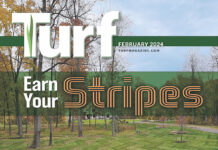On Sunday, the San Francisco 49ers will take on the Kansas City Chiefs in Super Bowl LVIII at the Las Vegas Raiders’ Allegiant Stadium in Nevada. For the week of local practice before the big game, the Chiefs have been working out at Allegiant Stadium, while the 49ers are at the Fertitta Football Complex at the University of Nevada-Las Vegas (UNLV).
To prepare for the 49ers to practice on the UNLV field, the NFL laid natural grass over artificial turf, and the result has not been to the team’s liking, according to a CBS Sports report.
The problem? Some players said it’s too soft.

According to CBS Sports’ sources, the 49ers’ equipment staff and grounds team checked out the facilities prior to the team’s arrival. Despite meeting all NFL, NFL Players Association (NFLPA) and other standards, the newly-installed natural grass was reportedly too soft for the team to practice on.
The NFL uses the “Clegg” test, which measures a field’s firmness, to make sure a field is up to code. NFL fields have to be at or below 100g (units of gravity) to pass.
The firmness of the grass isn’t a health or safety issue, but an issue of preference. The natural grass at UNLV measures around 50g, but the 49ers have a preference around 70g, according to the CBS Sports report.
In his annual Super Bowl press conference on February 5, NFL Commissioner Roger Goodell said experts visited UNLV and declared the fields “playable” despite complaints from the 49ers.
“We had 23 experts out there,” Goodell explained. “We’ve had the union out there. All of them think it’s a very playable surface. It’s softer than what they practice on, but that happens. It’s well within all of our testing standards.”
According to an AP update, plastic was supposed to be placed on top of UNLV’s practice fields before the natural grass was installed, but never was. Despite that oversight and the resulting complaints, the 49ers continued to practice at the UNLV facilities — which the players otherwise showered with compliments — all week.
Natural Grass vs. Artificial Turf
Two days after Goodell’s presser, in his first-ever “state of the union” address on February 7, NFLPA Executive Director Lloyd Howell discussed the importance of installing grass fields.
Joint studies from the NFL and the NFLPA show little difference between injury rates on natural grass and artificial surfaces. However, players have complained about how their bodies feel after practicing or playing on artificial surfaces. According to an NFLPA survey, 92% of players prefer to play on high-quality grass, 6% percent were indifferent between grass and synthetic turf, and 2% prefer synthetic turf (mostly kickers).
“The one issue where there was unanimous commentary was, ‘At the end of the day, I want to play on the highest quality grass surface,’” Howell said.
“Grass fields have a lower injury rate,” he continued. “A difference in what kind of chronic pain they’ll be in for the rest of their lives.”

Of the 30 stadiums used by the NFL’s 32 teams, 15 have artificial turf and 15 have grass or hybrid grass (natural turf reinforced with synthetic fibers). The NFL doesn’t have specific regulations about the type of surfaces teams use, and there are various types of each.
During his press conference, Goodell was asked about NFL teams potentially mandating grass fields in light of the recently announced match schedule for the FIFA World Cup 26™. Host stadiums will install natural turf for those competitions.
“We think hybrid is really something to explore,” Goodell responded. “That’s what they use internationally… We want to try to get the best fields, and that varies market to market, climate to climate.”
Hopefully, the 49ers’ turf troubles will be behind them once the team takes the field for the Super Bowl.
Last year, the field was an issue for the NFL during Super Bowl LVII, held at the Arizona Cardinals’ State Farm Stadium when both the Kansas City Chiefs and Philadelphia Eagles were obviously challenged by the field’s slippery surface. NFL groundskeeper George Toma later explained that the field had too much water and not enough sunlight prior to the Super Bowl.
Similar to State Farm Stadium, Allegiant Stadium has a retractable field tray system with both artificial turf and natural grass fields. This allows the Raiders to play on the natural surface, which they prefer, while the UNLV Rebels football team can play on the artificial turf it reportedly prefers.
The NFL addressed any concerns in a conference call last month, CBS Sports reported.
“We have brought in a brand-new natural grass surface that is currently installed in the field tray outside Allegiant Stadium,” said NFL EVP Peter O’Reilly. “That has been in for a little bit now and is working through all our standard testing procedures that will take place over the time from installation up through the day before and that Saturday right before the game. Those adjustments and a core maintenance program are in place so we have an optimal field on game day.”
Read more Super Bowl-related news on Turf.
Football Field Fast Fact
In July, Allegiant Stadium obtained LEED Gold Certification by the U.S. Green Building Council (USGBC), and is now one of seven NFL stadiums to achieve LEED certification. Among its many other sustainability initiatives, Allegiant Stadium diverts grass clippings from Raiders Field to an onsite biomass machine. To date, 160,800 pounds of grass clippings have been composted or diverted.











![[VIDEO] Dickies®: Discover Workwear That’s Anything But Uniform](https://turfmagazine.com/wp-content/uploads/2023/06/1647663814-4b1a2a7742790a9b1e97a3b963477850192e1d6a9dfba9b07214a77bae25d6e3-d-218x150.jpg)































![[VIDEO] Dickies®: Discover Workwear That’s Anything But Uniform](https://turfmagazine.com/wp-content/uploads/2023/06/1647663814-4b1a2a7742790a9b1e97a3b963477850192e1d6a9dfba9b07214a77bae25d6e3-d-324x160.jpg)